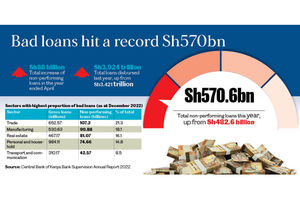
The Central Bank of Kenya headquarters in Nairobi in this picture taken on March 31, 2024.
Up to 20 commercial banks would need at least Sh238.99 billion in new capital each if their top three borrowers were to default on the loans they have taken.
This is more than double the Sh109.4 billion exposure prospect last year, implying higher concentration risk and increased susceptibility of tier one lenders to a few large borrowers.
This is according to the Central Bank of Kenya (CBK) Financial Sector Stability Report, which indicates that, in a worst-case scenario, such defaults per bank would see the 20 lenders breach the minimum capital requirements - commonly referred to as the Capital Adequacy Ratio (CAR) — by at least Sh238.998 billion. The industry regulator bases the findings on a stress test carried out in May this year.
"Under the single borrower/top borrower default per bank, the number of banks failing the stress test under severe scenario has increased in the May 2024 stress test compared to the May 2023 stress test. However, the amount of capital required to fully comply with regulatory core CAR of 10.5 percent more than doubles to Sh239 billion from Sh109 billion in the May 2023 stress test," the CBK says.
"This signifies increased concentration risk, implying banks in tier-one have become more exposed to a few large borrowers. If the single borrower severe scenario materialises, eight banks in the large peer group, four banks in the medium peer group, and eight banks in the small peer group will fail the stress test by December 2024."
According to the CBK, the eight tier-one banks account for 89.4 percent of the total possible capital shortfall.
In the report, the baseline scenario points to a capital requirement of Sh78.2 billion by 15 banks up from Sh26.2 billion by a similar number of lenders last year, while a moderate one would require Sh160.9 billion by 18 lenders up from Sh62.8 billion by 15 banks a year ago.
Among the assumptions underpinning the stress test scenarios included the monetary policy tightening, which would result in a rise of the average bank lending rate, a slowdown of lending due to elevated interest rates and increased credit risk, as well as the implementation of Treasury Single Account and reduction of CBK's balances due to commercial banks to 10-year average by December this year.
"The May 2024 Baseline (Uniform) stress test used shocks applied in the May 2023 stress test on the December 2023 data to assess the resilience of the banking sector in 2024," says CBK.










